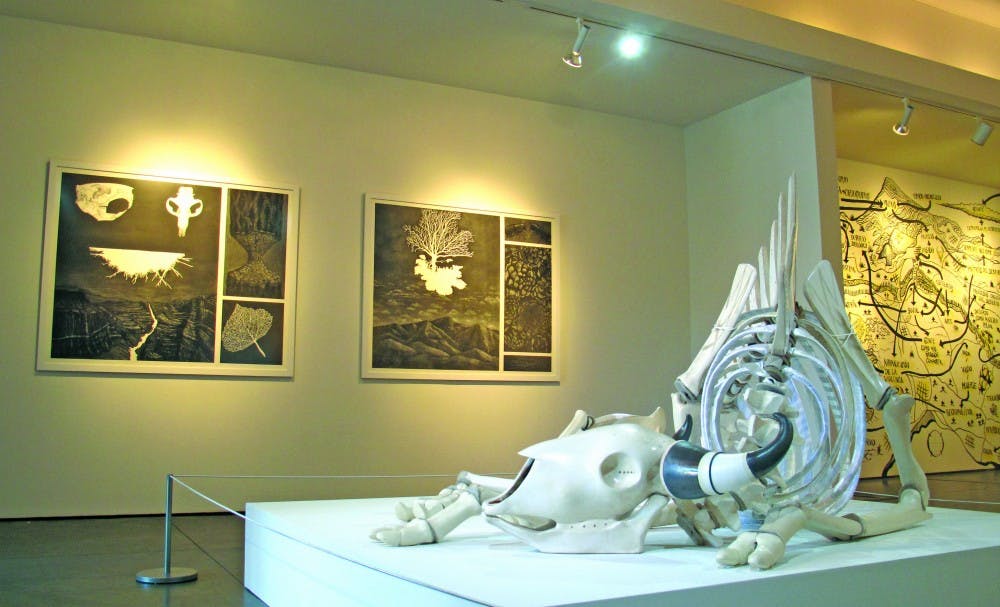Inside of the 516 ARTS gallery in Downtown Albuquerque, the Species in Peril art exhibit aims to bring recognition and acknowledgement to the pressing issue of biological extinction focusing on the Rio Grande watershed. The collaborative project is centered in Albuquerque but has satellite exhibits up and down the Rio Grande watershed.
Along the 1,885 mile long span of the river, thousands of species are threatened by human activity directly or indirectly. Human activity often reduces their habitats, threatening them with extinction.
These species include large mammals like the American bison, which historically lived on both the river in the United States and Mexico, and the endangered silvery minnow, which used to have an expansive range but has now been reduced to just a few miles in central New Mexico.
Artists from both sides of the river participated in the project, manufacturing incredible works of art that create a poignant visual of the environmental destruction and toll of human activity. The art work is a reflection of the reality of the biological situation but is not a death knell for the river.
According to Suzanne Sbarge, the executive director of 516 ARTS, the exhibit includes 23 artists from the Rio Grande watershed region. The exhibit allows contemporary artists to provide relevant artistic commentary that raises ethical and cultural questions about human actions and the consequences of these actions, according to Sbarge.
"How does the river connect us?" Sbarge asked, declaring the mantra for this project.
As the co-curator of the exhibit, UNM professor of art and ecology Subhankar Banerjee said "the biological crisis" is the global loss of species on a mass extinction level.
He also said raising awareness of the biological crisis to the same level as climate change is the focus of the project.
"We all know the climate crisis. Everywhere the young people have basically taken over the campaign," Banerjee said.
The 516 ARTS gallery takes advantage of the Southwest’s unique ecology and the connections of the diverse people in the area to host the exhibit here. Indigenous communities were heavily involved in the direction of this project, and many of the exhibit’s artists are from indigenous communities along the river, Banerjee said.
He noted the purpose of the exhibit is different from most art exhibits — even those that are curated with commentary in mind. Rather, it was created to inspire people into action by creating community. Even school groups, from pre-K through college students, have visited the exhibit, Banerjee added.
"This is about engaging the biological crisis through creativity, scholarship and teaching," Banerjee said. "The biological crisis is more expensive than the climate crisis when measuring in casualties (of species dying off)."
Get content from The Daily Lobo delivered to your inbox
The exhibit included sculptures, multimodal pieces, photographs, prints and more. Each piece had a page dedicated to it within the catalog. The catalog also included information about the works themselves, the artists, ecological facts and explanations.
Just as the climate crisis is being addressed by the United Nations, so is the biological crisis. Banerjee said the Intergovernmental Panel on Biodiversity and Ecosystem Services (IPBES) reported that one million species face extinction, many within only decades.
"That is nearly half of the documented species on earth," he said.
"We are the most destructive species to inhabit the Rio Grande Valley," exhibit artist Jessica Gross said. "Rats followed us here, invading with us. We are remarkably similar — they share our ability to adapt and thrive in widely varying environments… Someday, humans and rats may be the only animals (left) here."
The exhibition will be shown until Dec. 28 at 516 ARTS. The gallery is open from noon to 5 p.m. Tuesday to Saturday.
Megan Holmen is the news editor at the Daily Lobo. She can be contacted at news@dailylobo.com or on Twitter @megan_holmen
Colin Peña is a beat reporter at the Daily Lobo. He can be contacted at culture@dailylobo.com or on Twitter @penyacolin






